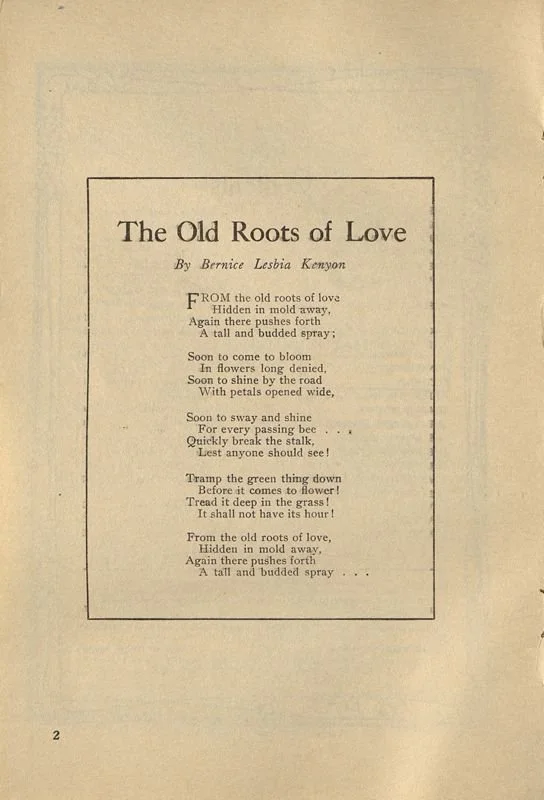The Poetry of Bernice Lesbia Kenyon
March is Women’s History Month. NY1920s always centers women’s history; this month we’ll do so a bit more emphatically.
TODAY’S GUEST POST IS BY EMILY SCHUCK (SEE COMPLETE BIO BELOW)
One hundred years ago today … Bernice Lesbia Kenyon’s poem “The Old Roots of Love” appeared in the March issue of The Smart Set, which had offices at the St. James Building, later moving uptown to Fifth Avenue.
“The Old Roots of Love” has five quatrains (four-line stanzas) with an alternate rhyme scheme (a rhyme every other line).
Kenyon’s work elicited an unimpressed review from Howard Nemerov in The Sewanee Review:
Bernice Kenyon does not appear to care for words very much at all; . . . It is a sad poetry, [her references to] summer and spring, and day light, appear only as charming villains do in the movies, admitted to a temporary triumph already seen in the melancholy-virtuous after glow of the bad end the producer's code has doomed them to.
The form and detail in this poem deserve attention. The repetition of the first and last stanza resembles Lewis Carroll’s “The Jabberwocky” (1871), Alfred Noyes’s “The Highway Man” (1906), and Robert W. Service’s “The Cremation of Sam McGee” (1907), none of which have fallen out of popularity today. Perhaps this formal choice was distasteful to the modernist poetic palate.
The choice of punctuation after the first and last stanza are of note: the semicolon following the first and the ellipses following the second suggest a cyclicality that mirrors the progress of the titular botanic root, if in overly sentimental language. The poem is, if nothing else, sweetly hopeful, despite the imperative tone of destruction in the penultimate stanza.
Though often compared to Edna St. Vincent Millay, Kenyon has drawn little attention from scholars in the twenty-first century, perhaps with some merit. A blog titled The Neglected Books Page calls her collection Songs of Unrest (Charles Scribner’s Sons, 1923) “unfortunate and misleading.” The same blog tags this entry as “justly neglected?”
The hugely influential Harriet Monroe, founder of Poetry Magazine, viewed Kenyon’s work with ever-so-slightly more favor: “conversational in tone and built for lightness and grace—skillfully fitted to the newspaper columns where it was first printed.” (A similar criticism was made of Millay in the Times, “a trifle magazinish.”)
Monroe continued to posit that “there is hardly enough lyric intensity and variety to place Miss Kenyon ‘among the few really fine lyric poets of our generation,’ according to the jacket’s promise; but on a somewhat lower level of artistry she speaks for more people, perhaps, than listen to the masters.”
There is little information widely available about Kenyon, but her New York Times obituary (she died in May 1982) reports that she graduated from Wellesley College and worked alongside Ernest Hemingway and F. Scott Fitzgerald at Scribner’s.
Of her own work, Kenyon wrote “You ask whether I think making a poet name his own best work is a wise or successful way. My answer would be: If the poet can name a preference he ought to be fairly right. . . . I am not speaking of my own work merely, but that of all of us.”
About Songs of Unrest, she emphasized that “So many people want to know what I mean by ‘unrest’ in the title of my book. I hasten to explain that it’s youth’s unrest and not social unrest!”
She published three collections of poetry during her lifetime, Songs of Unrest, in which the above poem appears; Meridian (1933); and Night Sky (1951).
Though Kenyon’s poems are markedly not canonical, they have a quiet beauty about them that elegantly reflect a pervasive tenderness: a quality that is too often undervalued and too frequently overlooked.
References/Works Cited:
Bartlett, Alice Hunt. “The Dynamics of American Poetry III.” The Poetry Review v. 15, 1924, p. 34–9.
“Bernice Kenyon Gilkyson, 84, Poet and Editor at Scribners.” Obituary. New York Times. 15 May 1982, 34.
“Bernice Kenyon, Poet.” The Neglected Books Page, March 2, 2016.
Dolmetsch, Carl. The Smart Set: A History and Anthology. Dial Press, 1966.
Nemerov, Howard. “The Careful Poets and the Reckless Ones.” The Sewanee Review, vol. 60, no. 2, Johns Hopkins University Press, 1952, pp. 318–29, http://www.jstor.org/stable/27538143.
– Emily Schuck, 23 March, 2022
Emily Schuck is a PhD candidate at Claremont Graduate University. Find her on Twitter @emilyschuck.
TAGS: Women poets, poetry, The Smart Set, Women's History Month, Bernice Kenyon, Scribners, little magazines


